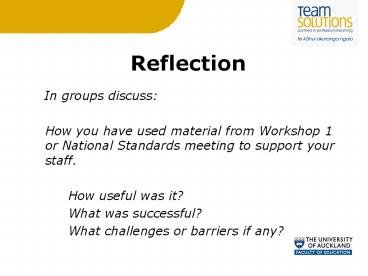Reflection - PowerPoint PPT Presentation
1 / 24
Title:
Reflection
Description:
Reflection In groups discuss: How you have used material from Workshop 1 or National Standards meeting to support your staff. How useful was it? What was successful? – PowerPoint PPT presentation
Number of Views:42
Avg rating:3.0/5.0
Title: Reflection
1
Reflection
In groups discuss How you have used
material from Workshop 1 or National Standards
meeting to support your staff. How useful was
it? What was successful? What challenges or
barriers if any?
2
Rich Task
- Emmas Journey
3
Making an OTJ in relation to the mathematics
standards
4
Perception Check
- How has your understanding of an Overall Teacher
Judgment changed since our last workshop?
5
Making an OTJ
- Overall teacher judgements of achievement and
progress involve combining information from a
variety of sources, using a range of approaches.
Evidence may be gathered through the following
three ways - Conversing with the student to find out what they
know, understand and can do. - Observing the process a student uses.
- Gathering the results from formal assessments,
including standardised tools. - This 'triangulation' of information increases the
dependability of the overall teacher judgement. - Fact sheet 7 Overall Teacher Judgement, MOE,
2010.
6
Sources of evidence to support OTJ
Observation of Process Evidence gained from
informal assessment opportunities
Learning Conversations Evidence arising from
Learning Conversations
- Focussed Classroom Observation
- Student books and tasks
- Running Records
- Student peer assessment
- Gloss and IKAN
- Conferencing
- Interviewing
- Questioning
- Explaining
- Discussing
Overall Teacher Judgement
Test Outcomes Evidence gained from assessment
tools, including standardised tools
- 6 year Observation Survey
- PAT
- Star
- E-asTTle/AsTTle V4
- GLoSS and IKAN
7
Watch Nathaniel
8
Evidence Time!
- Look at the types of evidence. What do you
notice? - Look at the evidence again. Is there anything
that is useful in making an OTJ? Is there
anything that is useful for teaching and learning
steps? Is there anything that is not useful at
all? - Refer to the OTJ diagram and Healthy Pyramid.
Where does the assessment evidence currently sit?
9
The Healthy Pyramid Practice Classroom Assessment
Information Source
Use Little
Aligned to learning goals
Use Some
Use Lots
For STRENGTH of information, use multiple
samplings from multiple sources. NZEI Te Riu
Roa and Lester Flockton, 2009.
10
In your groups discuss the following
First Make a best fit overall teacher
judgment. Circle the different aspects of the
National Standards based on the evidence you
have. Second Consider judgment in relation to
students age or year level. Third Identify
next teaching and learning steps.
11
(No Transcript)
12
1 1 2 2 3 3 4 4 5
After 1 year After 2 years After 3 years End of Y4 End of Y5 End of Y6 End of Y7 End of Y8
2 3 4 5 5 6 6 7 7 8
13
What are the implications for your school?
- What are you currently doing well?
- What aspects of data gathering may you need to
develop further? - How would you start or refine the OTJ process in
your school? - What further support do you need in this area?
14
Reporting to Parents
15
- Brainstorm what key features/elements need to be
included in a written report to parents?
16
NAG 2a
- Reporting to parents
- Written in plain language
- Twice a year
- Reporting to the Board of Trustees
- Including in the schools annual report the
number of students at, above, below and well
below the standard including Maori, Pasifika and
gender
17
Principles for Reporting
- Supports learning and next steps
- Language clear and easily understood
- Honest and transparent
- No surprises
- Strengthens educational partnerships with
students and whanau
18
Through reports parents should understand
- What their child can do and how they have
progressed. - Their childs progress and achievement in
relation to the standard for their year level. - Their childs goals.
- How they can help.
19
Content of a report
- Ask community what they want in and from reports.
- Should start with what the student has learned
and can do.
20
Using Plain Language
- In your groups discuss the language that maybe
used to describe a student who at the end of the
year is - Meeting
- Exceeding
- Working towards the standard.
- How would you reporting statement differ for a
mid-year report? - Share your report exemplars in your groups.
Consider the principles for reporting that enable
parents to understand where there child is at.
21
Reporting on Nathaniel
- Using the data available write a report for
Nathaniel. - Consider judgment in relation to students age or
year level and what statement you might write. - Consider progress and achievement.
- Consider how the language would differ for a
mid-year report? What would teachers need to
consider?
22
Reporting to parents
- Standards are written for end of year.
- But need to report to parents in writing twice a
year. - The first report should be in relation to
expected progress and achievement towards the end
of year target.
23
A Sweet Treat for Mum
- Get into groups of 4
- Using the materials provided, create an
appropriate package for a sweet treat for mum
for (2 people). - Make a label for your package. It must have 2 of
the following reflection, rotation, enlargement
and translation (2 people).
24
Analysing the Mathematics
- What are the mathematical progressions for the
strand areas that were evident in your rich task?
Complete the sheet on your table.































